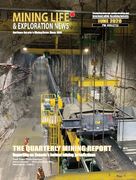Noront faces difficult choice in selecting its ferrochrome smelter
Timmins, Sudbury, Thunder Bay and Sault Ste. Marie are in the running
Alan Coutts, Noront Resources CEO, addressed a conference sponsored by the Sudbury Chamber of Commerce yesterday, four days after the application deadline for communities wishing to be in the running the company’s ferrochrome smelter.
For those hoping that Coutts would provide news of he was in the lead – he did not tip his hand
"It's not an obvious slam dunk for one community," said the company's CEO Alan Coutts. "There's no one proposal that was head and shoulders above all the others."
Coutts said the company anticipated each pitch would be strong.
"It's great because everyone put on their thinking caps, became creative, and has come forward with compelling proposals."
Timmins, Sudbury, Thunder Bay and the Sault, are the cities vying to host Noront’s ferrochrome smelter.
"We'll distill those bids down and say, right, we've got a designed plant -- we know how much that costs indicatively," he said. "Now, how much can we take off that bill because we're repurposing a brownfield site ( a site previously used for industrial purposes) ?"
Nickel from Eagle’s Nest Mine to be smelted in Sudbury
Before turning to mining chromite, Noront will start off with the mining of nickel at their Eagles Nest mine. The nickel will be smelted and refined in Sudbury through arrangements with one of the Nickel city’s existing smelters.
The plan is to ship nickel concentrate to Sudbury for smelting, said Coutts. His prediction is Noront is "five years out" from that scenario.
The Eagle’s Nest mine will start as soon as a permanent transportation route is completed.
The final four
In Sudbury the location for the ferrochrome smelter is in Coniston, an old smelter site that remains owned by Vale.
Timmins is offering the Glencore Kidd Creek MET site smelter, in the east-end along Highway 101 with access to a rail link.
While Thunder Bay is proposing a property on the port lands and opportunities for bulk shipments using the city’s ports that connect to international markets via the St. Lawrence Seaway.
Sault Ste. Marie proposed a brownfield site located on Algoma property and zoned for heavy industrial and close to its ports.
Criteria
Coutts said using brownfield sites with existing infrastructure such as electricity and rail results in, savings as opposed to starting from scratch at greenfield sites.
"Also, from a permitting point of view, it's a lot cheaper to do environmental assessments and repurpose a site than to do a brand-new construction in a greenfield area," he said.
Transportation from the mine site to the smelter is a major consideration.
"How efficiently we can move materials to and from the smelter and where is the smelter -- how close is it to the Ring? How close is it to markets?" Coutts said.
Next Step
In selecting a location for the ferrochrome smelter Noront is following a willing host community approach in its environmental assessment.
Coutts said the company will release the criteria and rationale for the selection. "It's a public process, so the answer is going to be public, as well."
“There is also the broader question of community support and other intangibles. "Are there universities and colleges?" Coutts said. "Are their experienced tradespeople and contractors that can play a role?"
Hatch Engineering has been retained by Noront to evaluate the bids and expects to decide in three to four months.
http://norontresources.com/update-on-ferrochrome-production-site-and-exploration-activity/
First Nations
Another aspect of bringing the first project in the Ring of Fire to life ins working with First Nations community to win their support.
The first Noront mine to open will in fact be a nickel mine know as Eagle’s Nest site within a few years and soon as an all-weather road.
The Road
On August 2017 Premier Kathleen Wynne gave her government’s support and announced an agreement reached with three First Nations (Webequie, Marten Falls and Nibinamik First Nations) on the building of an all season road that would link the communities to Ontario’s existing road system.
The road would also be designed to transport minerals such as nickel and chromite from the Ring of Fire
The road is expected to be designed, approved by the end of 2018 according to statements from the Premier’s office and ground breaking to build the road would begin in 2019.
"We're very enthused about the pace of development on the roadwork," Alan Coutts said, “with the government committed to having shovels in the ground by next year.”

|